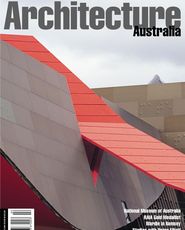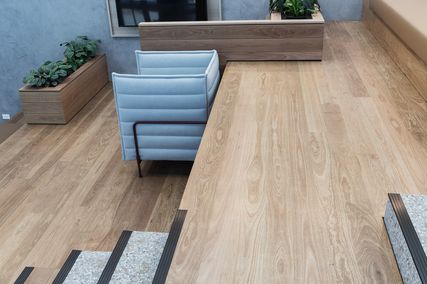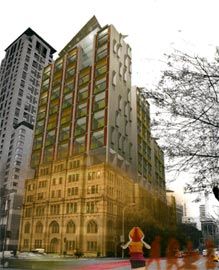
Outcome from the City of Sydney’s Design Excellence Program: Tonkin Zulaikha Greer’s design for the Scotts Church site, in association with JTCW.

Nation Fender Katsalidis’s World Square scheme. Image Bozig Design.
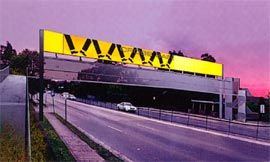
The three developed designs for a pedestrian bridge from the RAIA NSW Chapter’s Emerging Practices Program: David Haertsch and Peter McGregor.
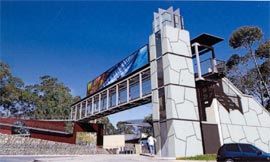
Tony Caro and C3D Design.

Lippman Associates. Image Digital Pulse.
The number of formal programs, strategies, and initiatives
striving to improve ›› the built form of Australian cities is increasing. A renaissance of interest in the city’s ›› urban form is underway. It is, however, too early to assess the efficacy of these ›› initiatives on our cities. But it is possible to see three impacts these new processes are ›› having on the design professions. None of the individual initiatives is perfect or pretends ›› to be the ultimate in process. Yet who ever said there was a perfect process or rulebook ›› for good design? In fact, the increase in initiatives and interest only declares more ›› publicly the challenge that is inherent in the practice of architecture and urban design.
A number of new initiatives are opening up opportunities for new practitioners to ›› take on public and private works they would normally not be given. One in particular, ›› the RAIA’s Emerging Practices Program, now has the potential to invite thirty ›› emerging practices to compete for work up to $5 million. The first project in this ›› program resulted in three firms (Tony Caro/C3D Design, Ed Lippmann and David ›› Haertsch/Peter McGregor) chosen from an invited list of eight by the RAIA, the ›› Department of Public Works and Service and the Roads and Traffic Authority to each ›› fully design a pedestrian bridge. The program promises to allow for fresh voices to ›› shape projects often untouched by the profession, or those typically touched by more ›› seasoned hands.
Another program developed by the City of Sydney – the Design Excellence Program ›› – aims to let practices into work in the development arena who otherwise would not, ›› through normal processes, have this opportunity. The program, driven by Lord Mayor ›› Frank Sartor to improve quality in city buildings, requires developers of projects over ›› 1500 metres square or 55 metres high to host a limited competition between three ›› architects prior to making a final selection. A selection panel comprised of six ›› members, including three representing the developer and three representing the ›› consent authority, judges the three submissions and determines the final designer. This ›› process opens the minds of developers to a range of possibilities on a site. Further it ›› declares publicly that good design is demanded by government, and should prevail in ›› the final built outcome. Projects having employed this process to date are World ›› Square, where Nation Fender Katsalidis was selected over Denton Corker Marshall ›› (DCM) and Harry Seidler, and the redevelopment of Scotts Church, where Tonkin ›› Zulaikha Greer, in association with Jackson Teece Chesterman Willis, was selected over ›› Hassell in partnership with Durbach Block, and DCM.
The Design Excellence Program is sparking much debate across the city. Who ›› chooses the winner? Who nutures the project once the competition is won? Who can ›› be assured that quick responses to complex briefs will meet the developer’s needs and ›› budgets? Why should three firms invest resources in return for a small payment in ›› what amounts to an expensive lottery ticket? It is too early to answer accurately. One ›› certainty is that this process will induct new practices in the complexities of ›› commercial work which in turn will improve the quality of city buildings.
Other strategies focus on nuturing clients. At Brisbane City Council a new Urban ›› Design Advisory Panel comprised of independent design professionals is, through the ›› critical review of major civic works, advising and empowering local government staff to ›› make decisions critical to shaping our built environment. Importantly, this process is ›› enabling government staff to move confidently to support innovative design solutions ›› often outside the norm, and even outside planning controls if warranted. The Urban ›› Design Advisory Panel includes representatives from design academia, the RAIA, RAPI ›› and the private sector. It provides a monthly review of major civic works through ›› presentations made, at this stage, by council staff. The panel also intends providing ›› strategic advice to the City Council regarding the impacts of certain components of ›› planning instruments on city form and spaces. The Brisbane model, while new and in ›› its formative stages, shows promise in improving the city through the nurturing of its ›› decision makers.
Many other panels of similar name exist across Australia. Some offer little impact ›› due to their lack of support from respective city councils or authorities. Others are ›› disabled by untimely input, naive critique or panel members who project their own ›› vision above the designer and their brief. Others, such as the recently announced ›› Canberra Quality Design and Sustainability Assessment Kit, offer good rules of thumb ›› to guide projects, but would be imperilled if they were to recommend pattern book ›› urban design. As many of these panels attest, the design review process must be ›› rigorous, inquiring and interactive.
Another key outcome of these new initiatives is to increase the number of ›› custodians guiding the quality of urban design in our cities. Design alliances are ›› creating formal relationships across disciplinary boundaries. For example, the ›› Queensland Urban Design Alliance has the RAIA, RAPI and AILA partnering to focus on ›› issues and, where appropriate, to form a common voice. The reinstatement of the ›› position of government architect in Queensland, alongside the NSW position, ›› demonstrates the need and desire for design leadership across the states.
Each individual initiative has specific merit. No strategy is perfect, nor do they all ›› embrace the broad spectrum of elements that enable a project. Many focus only on the ›› design process and on enhancing critical appraisal of work; some focus on multi-disciplinary ›› discourse as a means of strengthening a project’s depth. What they all ›› have in common is that the quality of critique and guidance is dependent on the quality ›› of the individuals who make commentary and decisions on the various projects. What ›› is lacking is initiatives that sponsor research into the Australian city that can in turn ›› impact and benefit the practice of city making. I reflect here on the recent Urban ›› Design Task Force chaired by Lord Richard Rodgers as the Blair government entered ›› office. It is rare in Australia for design professionals to be granted opportunities to ›› study and research critical issues affecting the growth and quality of cities. The recent ›› NSW Premier’s Urban Design Advisory Committee’s Task Force into Residential Flat ›› Development comes close as a means of addressing an issue facing our built ›› environment via research and independent inquiry. All of us can only wish for more.
Bridget Smyth is an architect/urban designer and is currently Director Urban Design for
the Olympic Co-ordination Authority

